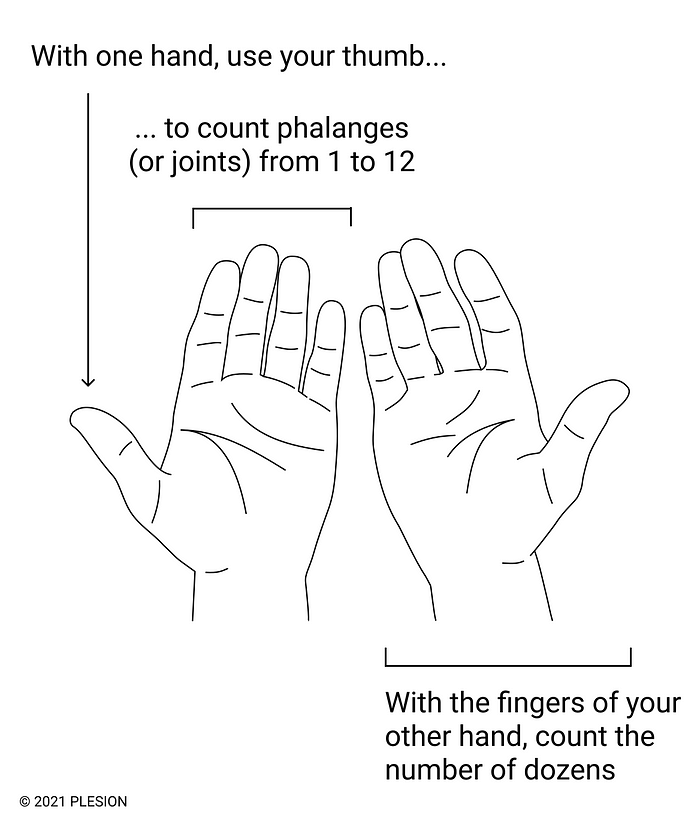A “handy” portable counter
Since the dawn of humanity, everyone has had the need to count things in everyday life. And everyone has had a simple portable counter to do so: one’s hands.
How can you count using your hands?
The first well known method is to count from 1 to 10 by deploying one finger after the other.

There is however a much more efficient method enabling you to count bigger numbers with your two hands.
Look at your two beautiful hands, and look closely at your fingers. Your thumb has two phalanges (and two joints) and each of your index, middle, ring and pinky fingers has three phalanges (and three joints).
Therefore with one hand, you can use your thumb to count joints on the 4 other fingers of this same hand: 3 joints on your index, plus 3 joints on your middle finger, plus 3 joints on your ring finger, plus 3 joints on your little finger. Twelve joints in total. Here is the dozen, a quantity which is still very much in use today.
Now, with your second hand, you can deploy (or close) one finger after the other and count the number of dozens, from 1 to 5.

This way you can count up to 5 dozens. Here comes the 60 of the sexagesimal system. Here is why humans have been counting in packs of 60 from the times of ancient civilizations until today.
More precise time units
You can tell your friends: “Let’s meet at 3 o’clock!”. The primary unit of time in a day is the hour. But if you need to define a time with more precision , you need a smaller unit than the hour.
The latin word minuta, feminine of minutus, means “made small”. So by dividing one hour, the primary unit, into 60 smaller equal elements, you get a new, more precise unit named the hour “made small”, or “minute”.
And if the “minute” (or hour “made small”) is still not a sufficient level of precision to define a time, you can simply use the process described above a “second” time. This “second” division, whereby you divide the minute into 60 smaller equal elements, gives you a new, more precise unit named the “second”.

More precise angle units
Now that we’ve looked at time, let’s have a look at space.
A standard way to define any given location on Earth is to give its latitude angle (North or South of the equator) and longitude angle (East or West of a reference meridian). While the primary time unit is the hour, the primary angle unit is the degree. To define an angle with more precision than the degree, we need a smaller unit. We will use exactly the same method for angles as the method we used for time.

Creating more precise angle units works exactly the same way as creating more precise time units. First, divide the primary unit by 60 to get a smaller unit. Second, divide this smaller unit by 60 to get an even smaller unit.
By the way, what’s a degree?
One last thing: where does the degree, as primary unit of angle measurement, come from?
Ask your middle school nephew or niece to lend you his or her compass and draw one circle, with a center named O and a radius R. Pick two points on the circle, first A, then B. Note that R = OA = OB.
The portion of the circle between A and B is called an arc, and the straight segment between A and B is called the cord of this arc. Now if you pick B such that the length of cord AB = R, you then have OA = OB = AB. In other words, the triangle OAB you’ve created is equilateral.

Now iterate by picking C on the circle, such that BC = R, then a fourth point D on the circle, such that CD = R.
Now, having drawn 3 equilateral triangles side by side, you can notice something interesting: D, O and A are aligned. In other words, the arc of the equilateral triangle is a third of a half circle or a sixth of a full circle. This arc is a good candidate to become a reference.

Back to our question, where does the degree come from? Well, I’m sorry for the repetitive nature of this story, but a degree is the arc of reference… divided by 60.
Number 60 has been in use for millennia to count things, and it’s been in use for centuries to define your precise location in time, and in space. The origin of this convention lies in the anatomy of your hands.
I hope you enjoyed this story about units of time and space. If you liked it, I encourage you to read our first story.
William, for PLESION, the universal bulletin board app.

